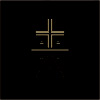Æthenor, "Faking Gold and Murder"
 Although it'll probably get the most attention for the participation of Sunn O)))'s Stephen O'Malley, this is much better looked at as an ensemble work that lacks overly sustained guitar drone in place of a bleaker, more complex atmosphere that, along with the vocals of Anok Pe David Tibet, conveys darkness in a more subtle, but equally as menacing way.
Although it'll probably get the most attention for the participation of Sunn O)))'s Stephen O'Malley, this is much better looked at as an ensemble work that lacks overly sustained guitar drone in place of a bleaker, more complex atmosphere that, along with the vocals of Anok Pe David Tibet, conveys darkness in a more subtle, but equally as menacing way.
A collaboration between the aforementioned O’Malley and Tibet, along with Vincent De Roguin (Shora) and Daniel O’Sullivan (Guapo), is a bizarre mix of kraut rock influenced dark mysticism, with a healthy dose of free jazz chaos and bleak dark ambient passages. The disc’s opening barrage of amphetamine fueled free jazz dual drumming over ominous electronic drones, coupled with the occasional metallic crash or bang. The drums continue along with processed organ stabs and creepy bells before the chaos drops out entirely.
The remaining portion of the first (of four untitled) tracks is left with sweeping symbol crashes, bells and Tibet’s vocals, which are more musical and less abrasive than much of his work with Current 93, but perfectly matches the demonic bleakness of the music. The drums actually stay mostly out of the mix for the remainder of the album, rather than aggressive, the music prefers to lurk.
The second piece opens with some bangs and clatters, sharp feedback bursts, and heavily effected ambient tones, much more sparse than the opening track. However, while it lacks the chaos of the first track, it does stay menacing, growing even darker with deep synths, bells, and chanted vocals. Tibet’s traditional vocals that appear near the end are double tracked, the slightly off-kilter sequencing of them only adds to the creepiness.
Part three begins in a similar way, hard panned stuttering percussion like unseen beings closing in from all directions, but just out of sight. The buried, pained vocals complement the dramatic piano and organ flourishes, the vocals eventually being cut up into fragments that resemble swarms of locusts, eventually letting the drums swell back up into the mix.
The final track clocks in at half the length of the previous ones, and closes the album with sustained ambient tones, soft vocals, and mangled guitar and organ tones. It is a fittingly dark and menacing ending to an apocalyptic album that leans towards more of David Tibet’s flirtations with the imagery instead of Stephen O’Malley’s…rather than maximalist dark noise and chaos, it is the subtle creepiness that colored Current 93’s best work that is more characteristic of this.
samples:



